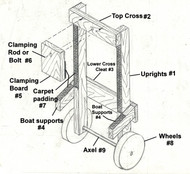Dinghy Cart You Can Build
Posted by Glen Witt on Aug 16th 2013
Getting the small dinghy or skiff over dry land to the water is quite a task. It's not so bad with two, but working alone can be a chore.
In the following we’ll describe and illustrate a wheeled device that attaches to the transom to enable a single person to move a sailboat or outboard boat of around 100 lbs. It’s much like a wheelbarrow; the bow of the boat is the “handles” and the twin wheels are substituted for the single one.
It’s built from readily obtainable materials and although the sizes of the components are called out, most any size and type of lumber can be used. The sketch shows how it’s made with parts numbered and the description listed in the following:
- Uprights, two required, 2” x 4”, height to suit that of boat transom plus space for the #8 Wheels and #2 Top Cross Cleat.
- Top Cross Cleat thickness to match that of transom (or clamping area for the outboard motor). Length and width may vary, preferably the space between parts #1 should be as great as possible. The Top Cross Cleat should be spaced so the underside slip fits over the top of the transom when the boat is resting on the #4 Boat Supports.
- Lower Cross Cleat, one required, 1”x 6”, length to lap over #1 and ends of #4.
- Boat Supports, two required, 2” x 4” x 12” (vary length to suit). The angle between #1 and #4 should be the same as for the angle of the transom to the bottom of the boat to be carried.
- Clamping Board, one required, to fit to the inside center of the transom. Size may vary; width to be that of the motorboard, about 12” from top to bottom, and made from 2” stock or ¾” plywood.
- Clamping Rod, 3/8” minimum bolt or threaded rod, length as required. Bore holes in #2 and #6 simultaneously to allow rod to slip loosely through these members. Provide flat washers and wing nuts on both ends of Clamping Rod. Note: Some may prefer two Clamping Rods spaced to be near the edge of #5. This provides a more rigid connection but is somewhat difficult to clamp on the boat transom.
- Carpet Padding (remnants) used on boat contact surfaces of #1, #4, #5 and underside of #2.
- Wheels, two required, 8” diameter (may vary), pneumatic or hard rubber, tread width as wide as possible. If cart is to be used over sand, tread should be as wide as possible and possibly two more wheels used between the insides of the #1 Uprights
- Axel, one required, diameter to suit that of wheel bore, length as required. Provide washers at contact with #1 Upright and washer and cotter key outboard the wheels.

